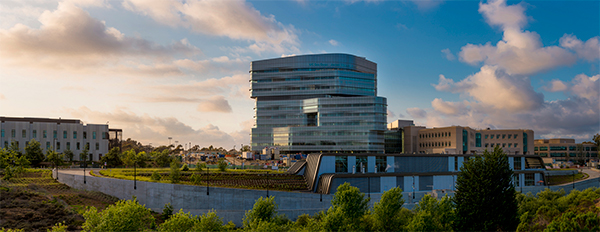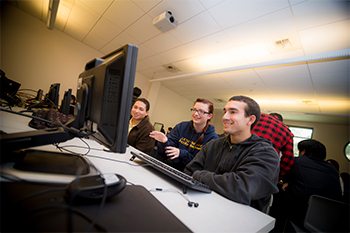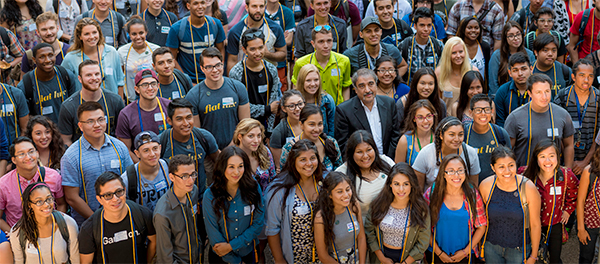Serving Our Campus, Our Community and Our World
January 7, 2016
Message from Chancellor Pradeep K. Khosla –
Letter Series: 3 of 3
Service is an integral part of our mission at UC San Diego. We serve our local and global citizens through our world-class education, transformative research, and the dissemination of knowledge and discoveries that benefit society. I have shared many of our service-oriented investments through my recent student-centered and research-focused letters. In this third letter of my three-letter series, I will focus on additional investments that are improving our service to campus, our community and our world.
Improving access and resources

We are currently re-envisioning our campus through our Long Range Development Plan to meet the evolving needs of our students, faculty, staff and community members. You may have already noticed some of the physical transformations taking place, which are increasing community access, reducing congestion and changing the way you get to, from and around UC San Diego. Examples include the addition of pedestrian walkways and bike paths in the heart of campus, and the completion of the Gilman Transit Center, which has streamlined the flow of traffic around buses and shuttles by creating bus turnouts. Construction is beginning to prepare for the addition of the Gilman Bridge, which will connect existing campus roads – Gilman Drive and Medical Center Drive – on both sides of Interstate 5. The bridge will enable campus members and other travelers to go from one side of the campus to the other without driving on busy city streets.
Several regional transportation projects are also in the works including the widening of Regents Road and the Genesee Avenue Interchange, both of which are designed to improve local traffic circulation and freeway access. The addition of the Light Rail Transit in 2021 will vastly improve community access to our campus as well. We are looking to add new student-centered facilities and open spaces, as well as enhance our University Center downtown neighborhood, in conjunction with the trolley’s arrival. UC San Diego’s east campus is expanding to enhance patient care and add important collaborative research space, with the addition of the Jacobs Medical Center later this year, the Altman Clinical and Translational Research Institute and Outpatient Pavilion. These service-oriented projects will increase the capacity of UC San Diego Health, which will help us to meet the future healthcare needs of our patients and expand our partnerships with physician groups and community clinics.

Maintaining our physical infrastructure is integral to providing the best possible living, learning and working environment at UC San Diego. Due to the lack of state funding over the years for building maintenance, numerous projects have been deferred but still need to be addressed. A recent facilities assessment identified our most pressing maintenance issues, and we are now expanding operational investment in facilities management to ensure the proper condition of our buildings. We continue to promote campus-wide support for energy and water conservation, including the expanded use of reclaimed water for irrigation and process equipment. This has enabled us to reinvest some of our savings generated through our energy efficiency efforts, with $2 million of those savings going into the cyclical maintenance of our buildings. As our campus gets older and continues to grow, it is important that we continue to invest in our building maintenance so we can ensure the safety of our campus members, support the sustainability of our facilities and avoid costly repairs in the future.
Building leadership and teams
Since his arrival a year ago, our Vice Chancellor and Chief Financial Officer Pierre Ouillet has enacted changes to increase efficiency and streamline operations of our $4 billion academic and research enterprise. One example is the streamlining of our annual budget process that changed how we review and establish budgets. Instead of an incremental approach to budgeting, we now start with a total view of each unit’s operating budget and conduct a bottom-up review, ensuring units are on stable and recurring resources whenever possible, and that existing and newly allocated resources are aligned with our Strategic Plan goals. We are also working to establish a Simplified Operating Fund to make expense accounting and fund management of unrestricted funds more efficient for business officers, resource managers and faculty. This pooling of funds will simplify financial transacting across the campus and allow departments to focus more on programmatic strategic outcomes for long-term financial sustainability of our campus.
A recent external review of our Information Technology function resulted in 10 recommendations to provide a more integrated IT organization across campus. One of the proposals led to our current recruitment of a senior Chief Information Officer to align our IT organization under a single campus office, Information Technology Services (ITS). This will help us to more effectively support our teaching and learning mission, expand the capabilities available to our research enterprise, and improve the effectiveness of our administrative functions and infrastructure.
Creating efficiencies

We’ve expanded our cloud services to take advantage of their scalability and increase cost efficiency. Cloud services allow us to leverage server infrastructure provided by vendors instead of hosting applications in a local UC San Diego datacenter. Examples include the move of student email from a home-grown system to Google’s Gmail platform, and the move of our campus web content management system to Amazon Web Services (AWS), a hosting platform for websites and web applications. This is beneficial because it allows our IT organization to handle the fluctuating load of data and usage, especially at the beginning of each quarter, but we don’t have to buy and maintain additional servers to handle the peak loads. We only pay for what we use and we have the added benefit of disaster recovery and back-up systems in case of outages outside of our control. Other efficiencies include the added services of Microsoft One Drive, Skype for Business and the Google Apps suite of tools for faculty and staff to better collaborate with students. These services integrate with campus Single Sign-On for ease of access, and facilitate mobile file sharing, collaboration, chat and video conferencing. ITS is continuously evaluating which services can and should be moved to the cloud, and what should be maintained on campus. As part of this, ITS ensures that the security of the outsourced data is the same as our local data center. Leveraging cloud-based tools and services, instead of building custom applications, helps us to efficiently and effectively serve the campus to meet our academic, research and business needs.
The Office of Operational Strategic Initiatives (OSI) was created as an outcome of the strategic planning process, charged to use best practices to ensure a service- and people-oriented culture that delivers an optimal balance of service with administrative and operational efficiency. OSI partners with campus units to accomplish both operational and financial goals that support the mission and goals of the university. One example is OSI’s work in continuous improvement on campus through a combination of coaching, process improvement initiatives and partnership with UC San Diego Extension to offer staff scholarships to their Lean Six Sigma certification – a methodology that relies on a collaborative team effort to improve performance by systematically removing waste and eliminating errors.
Another development is the creation of the Standing Committee on Service and People Oriented Administrative Culture, which guided OSI’s launch of IdeaWave to gather ideas for improvement and efficiencies, and to continue the open dialogue that occurred during the strategic planning process. By utilizing a social platform, all staff and faculty are able to submit, comment and vote on ideas as well as collaborate with colleagues and dynamically explore solutions with outcomes that advance our people- and service-oriented culture. IdeaWave is regularly launching campaigns on various topics to seek enhancements; the campaigns have generated more than 25,000 page views and established a productive dialogue that led to actionable solutions. Examples include Business Financial Services taking up the suggestion of augmenting MyTravel’s transaction pages to include the last four digits of a travel card to improve ease of processing, and the ONBOARDING Project allowing hiring forms and paperwork to be completed electronically before an employee’s first day. The most recent campaign is an effort to streamline the staff performance appraisal process.
Improving community outreach
UC San Diego has embarked on a comprehensive engagement initiative to advance the Strategic Plan goals of strengthening the connection between the campus and the community, and providing educational opportunities to underserved communities throughout the region. In June, UC San Diego Extension entered into a partnership with the Sycuan Education Department and the Viejas Tribal Education Center to provide college preparatory programs to middle and high school students, including UC San Diego Extension’s Academic Connections, a three-week summer program, as well as its other innovative college-prep summer courses in Arizona, New Mexico, Hawaii and Washington, D.C. In addition, Extension has a robust scholarship program for Academic Connections to ensure that students of different backgrounds and income levels are able to participate. Of the more than 373 students in Academic Connections 2015 class, 126 received some form of assistance totaling almost $275,000. Scholarship recipients include foster youth and students from Imperial Valley high schools, as well as participants of Reality Changers, a nonprofit that helps disadvantaged youth prepare to attend college. UC San Diego Extension has also partnered with Scripps Institution of Oceanography to provide STEAM education at Elementary Institute of Science, an educational nonprofit in Southeast San Diego. A partnership with San Diego Unified School District and Mar Vista High School in Imperial Beach provides free SAT/ACT test prep for low-income students who would not have the means or the opportunity to receive this service.

This past summer, UC San Diego launched the Office for Online and Technology Enhanced Education as part of the Teaching and Learning Commons to enhance education through technology. This includes offering online courses for credit, as well as developing non-credit certificate courses, and using online teaching to prepare younger students transitioning to UC San Diego and higher education.
I am extremely proud of our efforts to date to advance and fulfill our Strategic Plan goals and our vision as a student-centered, research-focused, service-oriented public university. It is because of our talented campus members that UC San Diego is able to transform lives and make our world a better place. Thank you for everything you do for UC San Diego, and I look forward to our continued success together.
With kind regards,
Pradeep K. Khosla
Chancellor